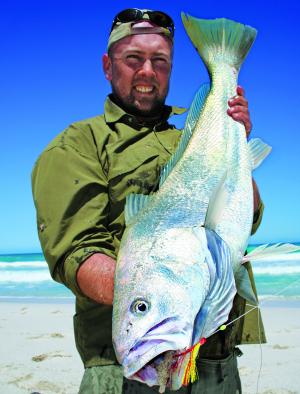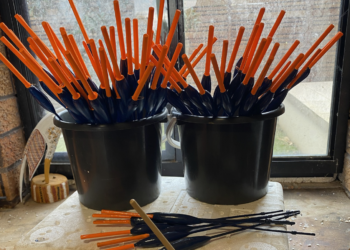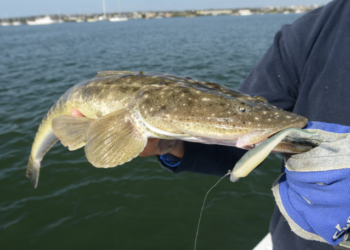If you want monster mulloway from the surf, you should gear up for an epic mission to the remote beaches of SA’s west coast. By ANDREW CLARK & SCOTT GREY.
WHEN it comes to fishing for big surf mulloway and snapper, there’s one location that reigns supreme when it comes to the quality and quantity of fish on offer. That place is Yalata, at the top of the Great Australian Bight along the west coast of South Australia.
Yalata is a truly remote fishing location. It’s about 980km from Adelaide to the Yalata roadhouse and then it’s about another 50km from the highway to the surf beach via 4WD tracks. This leads us to the first piece of essential equipment needed for a trip to fish at Yalata – a reliable 4WD. Once you gain access to the 4WD tracks off the highway, tyre pressures need to be reduced to deal with the soft terrain and generally will need to be deflated further once you get close to the surf beach where the 4WD tracks become made up entirely of sand. This means an electric pump will also be needed to reinflate tyres when heading home again. Additional recovery gear for 4WDs is also recommended. This includes a shovel, snatch strap and/or power winch. Ideally, if travelling in a group, it’s better to have a second 4WD vehicle travelling with you for safety reasons.
Along the coast at Yalata, there’s no power supply or fresh water, so a generator and a fridge/freezer unit as well as plenty of fresh water need to be brought in. In addition, you’ll need to bring with you all other camping gear, food and supplies. There’s no mobile phone reception in the area – the nearest phone is about 70km away – so if you want to be able to communicate with the outside world organise to hire a satellite phone.
The bottom line is this: you’re visiting a very remote location along the middle of the southern Australian coastline with no amenities. Anything you may need has to be brought in by you.
Season
There’s fishing on offer at Yalata all year round, but the best times to plan a visit are between October and May when the weather’s at its best. For many years it’s been a widely held belief that as the weather warmed up in the area, so did the fishing for big mulloway. In January and February, temperatures in the high 40s aren’t uncommon and this was the time of year most anglers headed to Yalata for big mulloway. Over the past few years this mindset seems to have changed a little with many keen mulloway anglers now considering November to be the peak time for these fish. In the end, Yalata is such a productive fishery any time of the year and during the warmer months is capable of producing good mulloway. Day to day variations in barometric pressure, prevailing winds and swell direction tend to play a greater role in success on the surf beach rather than which month of the year it is.
One benefit in planning an earlier trip to Yalata, particularly in October, is the chance of catching other species from the surf including big snapper and Australian salmon. At this time of year snapper of between six and 9kg can be caught, with larger specimens a distinct possibility. The Australian salmon at this time of year are also big, with most fish being between 4-5kg.
Different shark species are common at Yalata as well. Gummy sharks and bronze whalers can be caught year round, while school sharks tend to move in close to shore and can be targeted from the surf during January and February.
Spots
After arriving at your chosen camp site and setting up, it’s worth taking an hour or two to drive along the beach to assess likely areas to fish. As with any style of surf fishing, anglers need to look for deep gutters that run in close and parallel to the shore. The deeper gutters are characterised by darker, bluer water and also by a reduction in white water breaking over the top.
The good thing about surf fishing at Yalata is that often you can fish within a few hundred metres of where you’re camping, as many productive surf gutters are scattered along the shore line. In addition, the best gutters are often very close to shore, sometimes only five to 10m out.
Time & tide
As with many surf fishing situations, a rising tide, particularly the last two hours of it, is generally more productive at Yalata than a dropping tide. The logic for this is quite simple: when the tide rises there’s more water in the gutters; this, in turn, offers more protection for fish to move in to feed in the turbid water in close to shore.
Time of day doesn’t seem to have an appreciable impact on the best bite times at Yalata, particularly when targeting mulloway. Whether it’s the middle of the day or middle of the night, it seems to make no difference provided the tide is right.
Moon phases can have an impact on the fishing here, with the days surrounding the new and full moons being the best. This probably relates back to the best tides as with the new and full moon phases produce the biggest high tides during the month and therefore the deepest gutters and, you guessed it, the best fishing!
Tackle
One thing about fishing at Yalata is that any of the species you may encounter, whether it’s mulloway, snapper, salmon or sharks, chances are they’re going to be big, so high quality gear is a must. There is no point spending all the money and going to all the trouble of organising a trip to a place like Yalata only to cut corners on fishing gear. Two surf fishing outfits are needed: one as your main surf fishing outfit and another for catching live bait with. An optional third outfit can be used for lure casting.
As the main surf fishing outfit, you’ll need a rod between 10 and 12 feet in length, capable of casting 3-7oz sinkers and with enough grunt to fight a mulloway of up to 70 or 80 pounds. Obviously, if you’re expecting to encounter large fish you’ll need a solid reel that is strong, capable of dishing out adequate drag pressure and super reliable. In recent years there have been huge leaps forward in the quality of threadline reels with the purpose built Saltiga surf reels among the best on the market, in our view. Either the 4500 or 6000 Saltiga surf threadlines are more than capable of stopping the largest of mulloway encountered on surf beaches anywhere in Australia.
To catch live bait a smaller light outfit is essential, particularly for feeling the small bites. A 7-9 foot light to medium spinning rod with a 3000 sized reel loaded with 15lb braid is perfect for this type of fishing. Bait jig rigs are ideal and instead of putting a sinker on the bottom of the rig as a casting weight we use a 20g metal slice with a treble hook. This gives you the flexibility of casting lures or bait fishing and you don’t have to worry about getting snagged up.
Quality surf rod holders are essential to ensure that your reels don’t end up in the sand and they must be durable enough to handle the strike of a large fish taking the bait. Avoid leaving too much drag on the reel when you aren’t fishing right next to your rod or at night. About 1-2kg of drag is more than enough to hook a fish so ensure that you loosen off the drag if you plan to walk away from your rod.
Surf rigs
There are two types of rig we commonly use when fishing this area. The first is a simple two-hook paternoster rig which is ideal for presenting cut baits. We prefer using the pre-tied Black Magic “Snapper Snatchers” for this purpose. These flasher rigs are durable, are tied from 80lb Black Magic tough trace and have two droppers with hooks attached. Each dropper consists of an 8/0 KL circle hook, and a glow bead and tied fly is featured on each for added attraction.
To bait the circle hook bind up one end of the bait with bait elastic and hook the bait through once, leaving plenty of open gape on the hook to enhance the hook up. These rigs work extremely well fished straight out of a rod holder and 90 per cent of the time the fish is usually hooked before you even pick up the rod, as usually the weight of the sinker grappling into the sand is enough to hook the fish. On our last trip we had great success using this rig on mulloway and on consecutive occasions the mulloway ignored live baits set only metres either side of this rig to take the “Snapper Snatcher” rig baited with squid!
Alternatively, the very similar pre-tied Black Magic “Groper Grabber” rig is made up of heavier components and with two 200lb droppers and a 400lb main leader it is ideal for night fishing. This rig gives you a better chance of holding on to toothy critters like school sharks and bronze whalers in the darkness.
The second type of rig we use is single hook paternoster rig, usually with a single 80lb dropper connected to a 2/0-6/0 live bait hook. Live bait is dynamite in these waters if you can catch them and tommy ruff, juvenile Australian salmon and yellow eye mullet make excellent baits.
To bait up the livie take a small soft luminous glow bead and cut it in half. Thread the flat side onto the hook first then thread the live bait on through the eye socket. Complete the rig by threading the other half of the glow bead on round side first. The benefit of this is that it stops the baits sliding back up the line or off the hook in the rough water and secures the bait. At night the glow beads also provide added attraction.
It’s certainly worth putting in the effort to catch live bait and on our last trip we managed to land a respectable 7kg snapper on a live mullet. To catch live bait find a small gutter in close and use berley to draw the fish in. Multi-hook bait jigs are ideal for catching these fish as when a school comes through you usually get multiple hook-ups. Make the most of your opportunities when you can catch them and don’t expect to be able to get livies every day!
Bait
There are many types of baits that work in the surf at Yalata. Due to the remoteness of this location it’s a good idea to take plenty of bait with you, just in case it’s difficult to catch fresh bait on your arrival. Fresh frozen squid and octopus are ideal baits as they are preferred by many species and they are also tough enough to withstand the smaller pickers. Both whole dead fish baits and cut fish fillet baits also work well and are most effective when presented as fresh as possible. A fresh fillet of Australian salmon is an excellent bait for mulloway and snapper.
Permits
At Yalata the local Aboriginal community owns and manages the land that runs either side of the Eyre Highway from Nullarbor to the Nundroo roadhouse and includes around 100km of coastline.
To gain access to the surf beaches at Yalata, all visitors need to have permission and obtain a permit from Yalata Community Inc. Camping is only permitted in designated areas. Information relating to camping permits and areas can be obtained by visiting the Yalata Land Management website at www.yalata.org or ringing (08) 8625 6201. At the time of writing, permits cost $12 per day for adults or $25 per day for families. No alcohol or firearms can be brought into Yalata.





















